Dietary specialisation in the mushroom harvesting ant Euprenolepis procera
Sofia Lizon à l’Allemand and Christoph von Beeren recently published their interesting new paper „Competition as

Sofia Lizon à l’Allemand enjoying the field work during a rainy night 
Christoph von Beeren while observing a Dinomyrmex gigas worker at Ulu Gombak.
A Double Interview compiled by Phil Hönle

MNB: Hey Sofia and Chris, glad to have you for an interview. Could you tell us something about yourself?
SL: My name is Sofia and I’m a diploma biologist. I’ve started to work on a PhD thesis about specific ants that harvest and feed on wild-growing mushrooms, and the new paper in Myrmecological News is part of it. However, in the long-term I am not aiming for an academic career and started a nice job as project manager in a software company a year ago.
CVB: I’m Christoph von Beeren and I’m a postdoc at the TU Darmstadt. I am interested in diverse topics related to ants with special focus on army ant myrmecophiles. I participated in Sofia’s studies on the mushroom harvesting ants, as I too did my PhD studies in Malaysia.
MNB: Cool, so you did do your PhD at the same time?
SL: Yes we’ve been in the field at the same time and helped each other out.
CVB: Yes, exactly. We had a great time in Malaysia and an excellent PhD supervisor, Volker Witte, who sadly passed away a couple of years ago.
MNB: Could you briefly outline your recently published research about the mushroom harvesting ants in Myrmecological News in layman’s terms?
SL: There are these cool ants called Euprenolepis procera that can live on a strict mushroom diet, which is very unusual among ants. They don’t grow these fungi themselves like leafcutter ants do but collect a lot of different wild-growing mushrooms in the forest. Our paper aimed to figure out possible underlying mechanisms why they would do that. We hypothesized that being specialized on mushrooms releases these ants from competition, as other ants generally do not consume wild-growing mushrooms.
CVB: Previous to this study, it was clear from laboratory observations that E. procera colonies also accept food other than mushrooms such as honeywater and dead insects. However, Sofia and Volker figured out that the majority of food items in the field are mushrooms. So, we asked ourselves how to explain this discrepancy between field and laboratory food choice. Obviously, one idea was competition avoidance for other, more common, ant food.
SL: We investigated this by placing three artificial food sources on the forest floor: honey, tuna, and oyster mushroom. Then we noted which and how many ants occurred at the baits over time. As expected, there were lots of other ants on honey and tuna baits, but mushrooms were solely taken by two Euprenolepis species, which seemed to support our idea of mushrooms representing a competition-free niche space.
CVB: One observation was a bit surprising though. Our initial expectation was that Euprenolepis will be rare on honey and tuna baits because of high competition for these resources. However, it turned out that Eurprenolepis ants were among the most common ants on baits, also at honey and tuna baits. We think this might be related to high nest densities in the area and efficient recruitment.
SL: Indeed, Euprenolepis was surprisingly fast at baits! Not many other ants occupied the baits so quickly in high numbers and it turned out that Euprenolepis were clearly not so bad when it came to outcompeting ants. Often they did not disappear when other ants showed up but stood their ground. Nonetheless, Euprenolepis avoided to occupy honey and tuna baits when these were already utilized by other ants.
CVB: …which I think represents the main result of the paper. In absence of competitors, they utilized all three bait types equally while they avoided honey and tuna baits when competitors were present. Mushroom baits were always utilized at the same high rate.

MNB: Interesting observations! What is the take home message of your work?
CVB: I’d say that our result indicates that the diet specialization on mushrooms might have arisen as mechanism to avoid competition. Interestingly, they still retained some flexibility in their diet choice by utilizing more common ant food when competitors are absent. In contrast, mushrooms are not utilized by other ants, so they represent a virtually competition free resource.
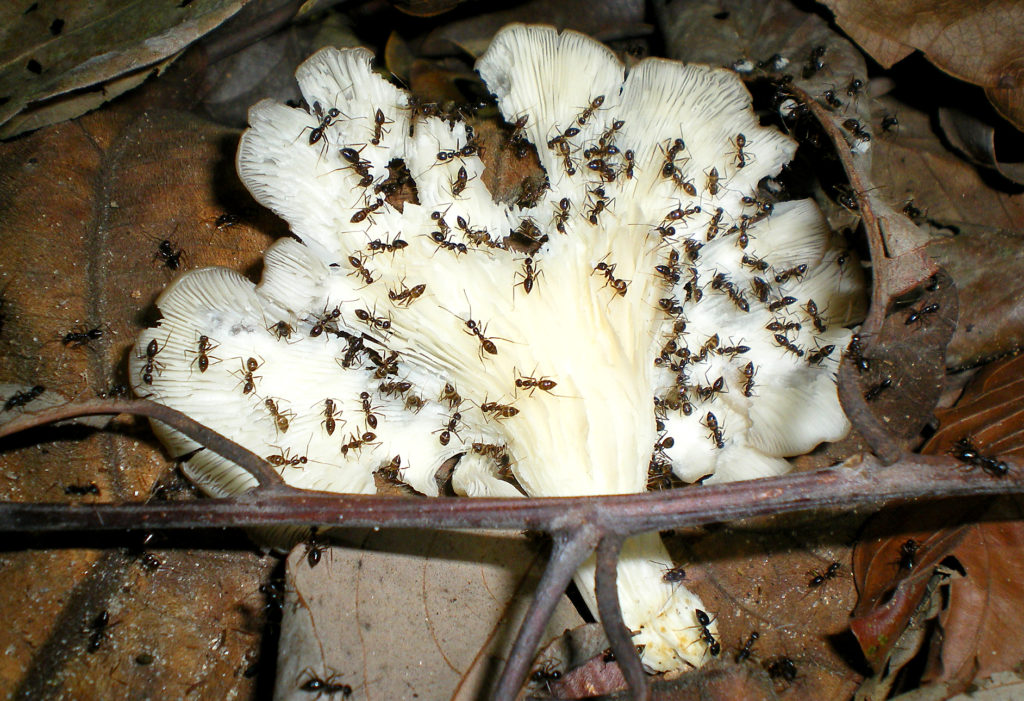
MNB: What was your motivation for this study?
SL: I knew that I wanted to do a PhD in behavioral ecology, and Volker offered me two different topics for this, among them studies about army ants, which Chris later studied. I first wanted to join Volker for a field trip to see the ants by myself. I was impressed by the high ant diversity at the place (Malaysia, Ulu Gombak) and also the many different methods I could learn within the project. Quickly, I realized that I really liked the Euprenolepis project and gave it a go. Just very cool ants.
CVB: I fully agree! I think the exceptional lifestyle of these ants make them a great subject for studies. Especially when you’re in the field and see them harvesting all the fresh mushrooms – this is just great. Hundreds of ants cut down the fungal fruiting bodies into little pieces, transport them into the nest and then start chewing the mushroom parts and storing them in little piles… this is just amazing to see.
SL: …and also a unique among ants!
CVB: This was one of Volker Witte’s great discoveries. He described the lifestyle of these ants together with Ulrich Maschwitz. Ulrich joined us during one field trip and inspired us with his great knowledge about ants, ant-plants, and other critters. Sadly, he passed away recently. When Sofia started her PhD little was known about the mushroom harvesters, and every little discovery was basically new to science.

MNB: Seems like there are still many knowledge gaps. Do you think other ants that specialize on wild mushrooms could be discovered?
CVB: I wouldn’t exclude it. Both known mushroom harvesting species belong to the genus Euprenolepis, and, as far as I know, we do not know what other species of the genus are feeding on. Since 2013, I’m doing my research in Costa Rica, and I have put out some mushroom baits there as well. However, no other mushroom harvesters were found yet. My overall impression is that there are much less mushroom bodies available compared to Malaysia, which might partly explain the lack of specialized mushroom harvesters in the Neotropics. There were really a lot of mushrooms in Ulu Gombak!
MNB: What was the biggest obstacle you had to overcome in this project?
SL: The parenting time [laughs]. No, the study itself went smooth without many troubles. It took several field seasons to get enough data, but the experiments were well designed and worked pretty well right from the beginning. Working on the data analysis turned out to be a bit tricky.
CVB: Yeah, we had quite some discussions about it and had very valuable input from Adrian Brückner, a talented scientist and former PhD student in Darmstadt who is also a co-author of the study.

MNB: Do you have any tips for others who are interested in doing related research?
SL: Simply do it!
CVB: I’d even encourage people to do it. It’s super simple working with Euprenolepis, you just need to go out at night and put some baits out to find them.
SL: Finding and keeping the ants in the lab is easy as well, and no other researchers are currently working on the topic, as far as we know. There are still many open questions.
CVB: It’s even something for people who don’t like to do field work very much, since you can just put out the bait, drink some beer, and return one hour later to collect the ants [laughs].
MNB: Where do you see the future for this particular field of ant research?
SL: In my opinion, the digestion of the mushroom is still the most interesting open question. It’s rather unusual for ants to be able to digest fungi, and many animals in general are not capable of doing it efficiently. That these ants are able to solely feed on mushrooms over months and thrive shows that they are able to get all essential nutrients from mushrooms alone. Unpublished results show that the ants do use chitinases to break down the mushroom cell walls – it’s not clear, however, whether these stem from symbiotic endosymbionts or if they are able to biosynthesize the chitinases themselves.
MNB: Is the next paper on these interesting ants in the works?
SL: Some data still exist, but we are not sure if we find the time for publishing those.
CVB: This was a main research field of Volker Witte. Unfortunately, nobody is really continuing his work, which is a bit sad. It would be great if somebody continues to study these fascinating ants. It wouldn’t be too difficult to get started! We are happy to help with advice.
MNB: Who inspired you to do research on ants?
SL: For me, this choice was rather random. I really wanted to do some behavioral research, and at my university in Munich there were not so many options – ants or birds as study systems. I chose ants, mostly because I met Volker, and I was fascinated by his research on ants. Personally, the methods I could learn were more important for me than the study organism.
CVB: I don’t even remember exactly. I was somehow always interested in ants, starting as a child. During my study time in Heidelberg, I read parts of Hölldobler & Wilson’s famous book „The Ants“, which enthused me. I then decided to do a diploma thesis in myrmecology and found a great opportunity to do this in the lab of Rüdiger Wehner in Zurich. He is a very impressive personality, and he is excellent at motivating you as a student. Later, Volker was a great supervisor as he managed to pass on his own enthusiasm for ants and tropical field work to me as a PhD student. He would sometimes catch snakes and other cool animals, so there was always something going on and it was never boring during field work! Another important person for my scientific career was Daniel Kronauer during my postdoctoral time in New York. I think it was mostly the people I’ve met during my career who gave me inspiration for research.
SL: I have to say at this point that Christoph himself was inspiring for my work, because he was always so incredibly enthusiastic when he started talking about ants [both laugh]!
MNB: What was the funniest moment during your field work?
CVB: Oh, there were many…. One time, Ulrich Maschwitz asked Volker to look for Crematogaster sexuals in Macaranga ant plants. Volker and I went up some logging paths, passing some feral, not very friendly dogs and hundreds of hungry leaches, and it took us quite some time to find a nice and large enough Macaranga tree. We were quite happy about it, and started to cut down the tree with our machetes to screen for Crematogaster sexuals in the stem and branches. That was quite some exhausting work! After some time, we were totally sweaty, we finally felled this tree, and screamed out of joy… only to then figure out that this actually was not a Macaranga at all! For sure no symbiotic ants either. Fortunately, the second one was the right one with thousands of sexuals in the stem – surely no botanist talent in us.
MNB: And the scariest moment?
SL: One time when Chris and I were together in the field hut there was a lightning that must have stroked the hut! Everything around us was completely bright for a second and this was a bit scary. I think we were lucky that we were inside a metal cage that was built around the cabins to protect it from monkeys stealing everything they can get hold of. No one got hurt, but it was definitively a fearsome situation.
CVB: I agree, it was. I also got lost in the forest one time. It was a bit scary not to know where to go, and I was alone in the forest. Every direction looked the same and at that time, we had no GPS or anything like that. Luckily, I managed to hear and find the main river of the forest there, the Gombak river, which I followed to eventually come back to the station.
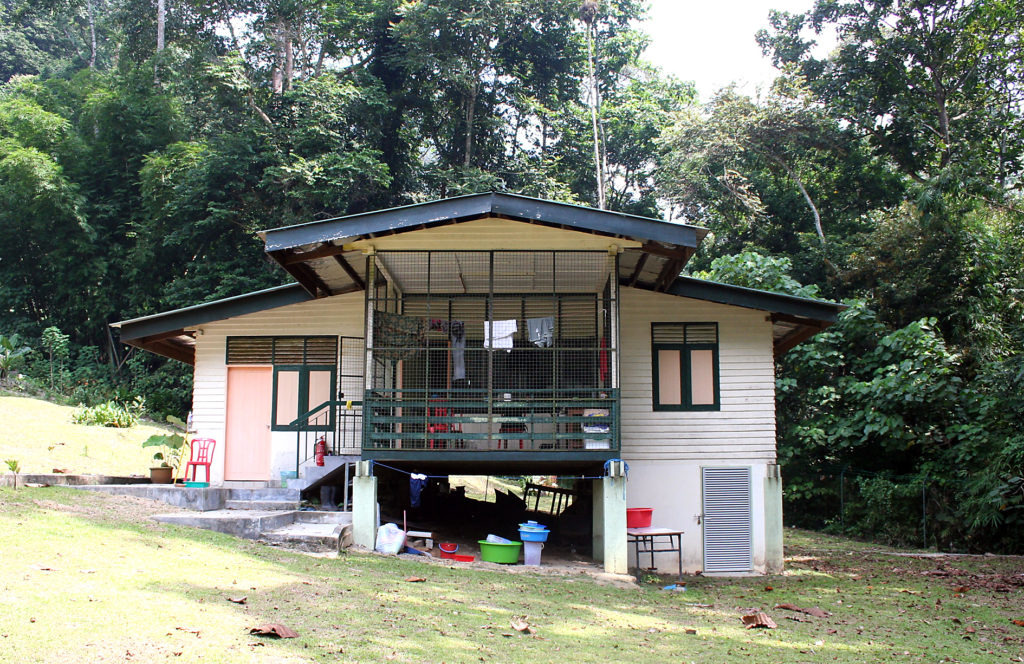
MNB: What’s the book at your bedside?
SL: No book there, no time to read.
CVB: Ninjago, a book from my son about lego ninjas. But I have also a book below of that for myself, „Das Große Insektensterben“ (The great insect mass mortality).
MNB: Watching sports or doing sports?
SL: Neither. Rather I’d do some, though.
CVB: Doing sports.
MNB: Do you enjoy the evening or the morning?
SL: Evening.
CVB: Morning.
MNB: Tee or Coffee?
CVB: Coffeee!! [Phil’s comment: Christoph is known in the lab for his coffee addiction leaving trails of coffee drops from the kitchen into his office]
SL: Neither.
MNB: Habit or change, what do you prefer?
SL: Change!
CVB: Habit!
MNB: Cooking yourself or going out for dinner?
SL: I prefer cooking by myself…
CVB: It depends; I prefer going out for dinner without the kids, but with them I prefer cooking by ourselves – more relaxing!
MNB: Aspirator or forceps?
SL: Aspirator.
CVB: Aspirator.
MNB: Nest densities or pitfall traps, what do you prefer?
SL: We both did not work with either before.
MNB: Fieldwork or lab?
SL: Fieldwork.
CVB: Fieldwork.
MNB: Pin or ethanol?
SL: Ethanol.
CVB: Depends. I rather have them pinned when I look at it, but it’s better stored in ethanol for genetics.
MNB: Paper printed out or reading on the laptop?
SL: Printing.
CVB: Printing as well, even though I try to change in that regard.
MNB: Journals financed by the author (open access) or by the reader (subscription based), what do you prefer?
SL: Open access
CVB: Open access
MNB: Kin selection or group selection?
SL: Group selection.
CVB: Then I take kin selection.
MNB: Do you prefer monodomy or supercoloniality?
SL: Clearly supercoloniality!
CVB: I prefer monodomy.
MNB: Do you prefer the workers or the queens in an ant colony?
SL: Workers are more exciting.
CVB: Males! [laughs] Otherwise queens are more exciting.
MNB: Thanks to both of you for that interesting interview!
Disclaimer: This interview was originally carried out in German and later translated to English.




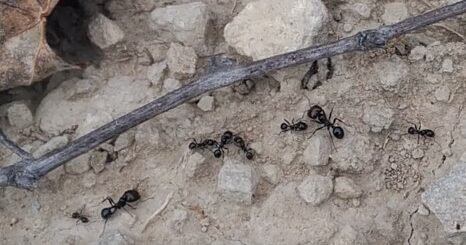
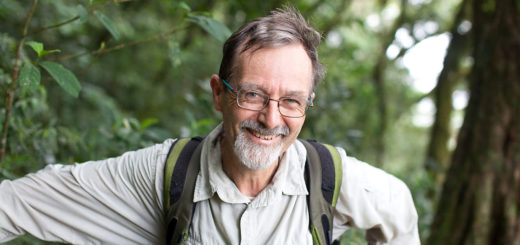
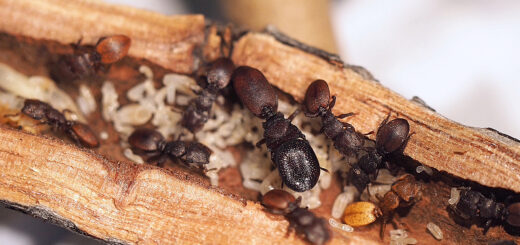
Recent Comments